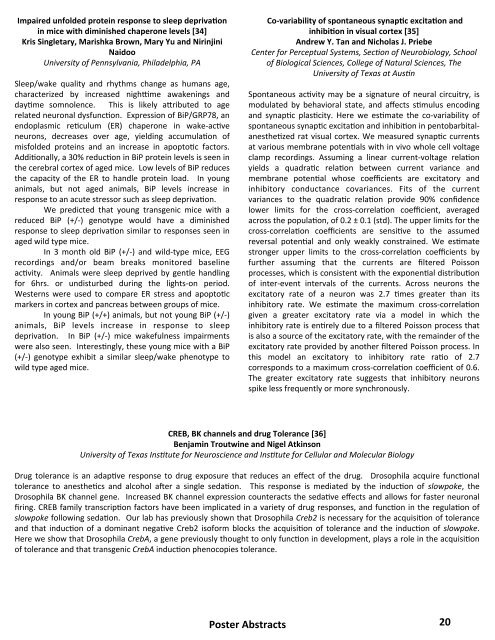Program - The Institute for Neuroscience - The University of Texas at ...
Program - The Institute for Neuroscience - The University of Texas at ...
Program - The Institute for Neuroscience - The University of Texas at ...
Create successful ePaper yourself
Turn your PDF publications into a flip-book with our unique Google optimized e-Paper software.
Impaired unfolded protein response to sleep deprivaYon<br />
in mice with diminished chaperone levels [34]<br />
Kris Singletary, Marishka Brown, Mary Yu and Nirinjini<br />
Naidoo<br />
<strong>University</strong> <strong>of</strong> Pennsylvania, Philadelphia, PA<br />
Sleep/wake quality and rhythms change as humans age,<br />
characterized by increased nighvme awakenings and<br />
day8me somnolence. This is likely aEributed to age<br />
rel<strong>at</strong>ed neuronal dysfunc8on. Expression <strong>of</strong> BiP/GRP78, an<br />
endoplasmic re8culum (ER) chaperone in wake-‐ac8ve<br />
neurons, decreases over age, yielding accumula8on <strong>of</strong><br />
misfolded proteins and an increase in apopto8c factors.<br />
Addi8onally, a 30% reduc8on in BiP protein levels is seen in<br />
the cerebral cortex <strong>of</strong> aged mice. Low levels <strong>of</strong> BiP reduces<br />
the capacity <strong>of</strong> the ER to handle protein load. In young<br />
animals, but not aged animals, BiP levels increase in<br />
response to an acute stressor such as sleep depriva8on.<br />
We predicted th<strong>at</strong> young transgenic mice with a<br />
reduced BiP (+/-‐) genotype would have a diminished<br />
response to sleep depriva8on similar to responses seen in<br />
aged wild type mice.<br />
In 3 month old BiP (+/-‐) and wild-‐type mice, EEG<br />
recordings and/or beam breaks monitored baseline<br />
ac8vity. Animals were sleep deprived by gentle handling<br />
<strong>for</strong> 6hrs. or undisturbed during the lights-‐on period.<br />
Westerns were used to compare ER stress and apopto8c<br />
markers in cortex and pancreas between groups <strong>of</strong> mice.<br />
In young BiP (+/+) animals, but not young BiP (+/-‐)<br />
animals, BiP levels increase in response to sleep<br />
depriva8on. In BiP (+/-‐) mice wakefulness impairments<br />
were also seen. Interes8ngly, these young mice with a BiP<br />
(+/-‐) genotype exhibit a similar sleep/wake phenotype to<br />
wild type aged mice.<br />
Co-‐variability <strong>of</strong> spontaneous synapYc excitaYon and<br />
inhibiYon in visual cortex [35]<br />
Andrew Y. Tan and Nicholas J. Priebe<br />
Center <strong>for</strong> Perceptual Systems, Sec5on <strong>of</strong> Neurobiology, School<br />
<strong>of</strong> Biological Sciences, College <strong>of</strong> N<strong>at</strong>ural Sciences, <strong>The</strong><br />
<strong>University</strong> <strong>of</strong> <strong>Texas</strong> <strong>at</strong> Aus5n<br />
Spontaneous ac8vity may be a sign<strong>at</strong>ure <strong>of</strong> neural circuitry, is<br />
modul<strong>at</strong>ed by behavioral st<strong>at</strong>e, and affects s8mulus encoding<br />
and synap8c plas8city. Here we es8m<strong>at</strong>e the co-‐variability <strong>of</strong><br />
spontaneous synap8c excita8on and inhibi8on in pentobarbital-‐<br />
anesthe8zed r<strong>at</strong> visual cortex. We measured synap8c currents<br />
<strong>at</strong> various membrane poten8als with in vivo whole cell voltage<br />
clamp recordings. Assuming a linear current-‐voltage rela8on<br />
yields a quadra8c rela8on between current variance and<br />
membrane poten8al whose coefficients are excit<strong>at</strong>ory and<br />
inhibitory conductance covariances. Fits <strong>of</strong> the current<br />
variances to the quadra8c rela8on provide 90% confidence<br />
lower limits <strong>for</strong> the cross-‐correla8on coefficient, averaged<br />
across the popula8on, <strong>of</strong> 0.2 ± 0.1 (std). <strong>The</strong> upper limits <strong>for</strong> the<br />
cross-‐correla8on coefficients are sensi8ve to the assumed<br />
reversal poten8al and only weakly constrained. We es8m<strong>at</strong>e<br />
stronger upper limits to the cross-‐correla8on coefficients by<br />
further assuming th<strong>at</strong> the currents are filtered Poisson<br />
processes, which is consistent with the exponen8al distribu8on<br />
<strong>of</strong> inter-‐event intervals <strong>of</strong> the currents. Across neurons the<br />
excit<strong>at</strong>ory r<strong>at</strong>e <strong>of</strong> a neuron was 2.7 8mes gre<strong>at</strong>er than its<br />
inhibitory r<strong>at</strong>e. We es8m<strong>at</strong>e the maximum cross-‐correla8on<br />
given a gre<strong>at</strong>er excit<strong>at</strong>ory r<strong>at</strong>e via a model in which the<br />
inhibitory r<strong>at</strong>e is en8rely due to a filtered Poisson process th<strong>at</strong><br />
is also a source <strong>of</strong> the excit<strong>at</strong>ory r<strong>at</strong>e, with the remainder <strong>of</strong> the<br />
excit<strong>at</strong>ory r<strong>at</strong>e provided by another filtered Poisson process. In<br />
this model an excit<strong>at</strong>ory to inhibitory r<strong>at</strong>e ra8o <strong>of</strong> 2.7<br />
corresponds to a maximum cross-‐correla8on coefficient <strong>of</strong> 0.6.<br />
<strong>The</strong> gre<strong>at</strong>er excit<strong>at</strong>ory r<strong>at</strong>e suggests th<strong>at</strong> inhibitory neurons<br />
spike less frequently or more synchronously.<br />
CREB, BK channels and drug Tolerance [36]<br />
Benjamin Troutwine and Nigel Atkinson<br />
<strong>University</strong> <strong>of</strong> <strong>Texas</strong> Ins5tute <strong>for</strong> <strong>Neuroscience</strong> and Ins5tute <strong>for</strong> Cellular and Molecular Biology<br />
Drug tolerance is an adap8ve response to drug exposure th<strong>at</strong> reduces an effect <strong>of</strong> the drug. Drosophila acquire func8onal<br />
tolerance to anesthe8cs and alcohol aBer a single seda8on. This response is medi<strong>at</strong>ed by the induc8on <strong>of</strong> slowpoke, the<br />
Drosophila BK channel gene. Increased BK channel expression counteracts the seda8ve effects and allows <strong>for</strong> faster neuronal<br />
firing. CREB family transcrip8on factors have been implic<strong>at</strong>ed in a variety <strong>of</strong> drug responses, and func8on in the regula8on <strong>of</strong><br />
slowpoke following seda8on. Our lab has previously shown th<strong>at</strong> Drosophila Creb2 is necessary <strong>for</strong> the acquisi8on <strong>of</strong> tolerance<br />
and th<strong>at</strong> induc8on <strong>of</strong> a dominant nega8ve Creb2 iso<strong>for</strong>m blocks the acquisi8on <strong>of</strong> tolerance and the induc8on <strong>of</strong> slowpoke.<br />
Here we show th<strong>at</strong> Drosophila CrebA, a gene previously thought to only func8on in development, plays a role in the acquisi8on<br />
<strong>of</strong> tolerance and th<strong>at</strong> transgenic CrebA induc8on phenocopies tolerance.<br />
Poster Abstracts<br />
20


